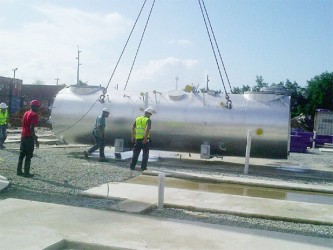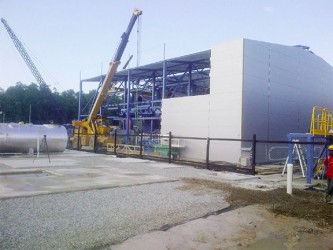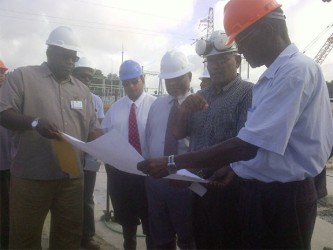Guyana Power and Light Inc (GPL) is looking to have its 26-megawatt power plant at Vreed-en-Hoop, West Coast Demerara commence commercial operations by the end of July after unprecedented civil works pushed the cost of the project up an additional US$6 million – US$9 million.
The new cost of the project will now be US$33/34million as Wartsila is still building the plant for US$26 million. The company was hoping initially to have the plant operational by the end of last year and when this deadline seemed unattainable a new deadline was set for this April.
GPL Chief Executive Officer (CEO) Bharat Dindyal, who visited the site with Prime Minister Samuel Hinds, several other company’s top managers, and members of the media last Friday, also said that the facility was just about 20% complete.

All of the components that are needed to complete the site have been imported and the most crucial components have already been taken to the site, Dindyal explained. He said that 98 per cent of the components which are to comprise the power plant have been taken to the location while the rest are still stored in 30 containers at the John Fernandes storage facility. All of the equipment could not be taken to the site because it is not big enough to store them all.
He said that the three Wartsila engines the largest ever brought to Guyana, and the hearts of the plant, have already been placed on their foundations and fitted, and that the contractors are working to construct a housing facility around them.
Two heat recovery boilers have also been placed on their foundations. Dindyal said that the contractor is also in the process of building the foundations on which the plant’s bulk storage tanks will sit.
This work is taking place on the western side of the power plant and once finished, two 2,000 cubic metres tanks, capable of together holding twelve and a half thousand barrels of fuel storage will sit on the foundation. This amount of fuel, Dindyal explained, will be enough to run the plant for 30 days.
He said though, that the plant will be sourcing shipments of fuel from marine vessels every ten days. The construction of a wharf to facilitate the sourcing of the said fuel is also underway and is being undertaken by BK International. The wharf is being constructed to the north of the site.
Challenges

The geographical location posed a challenge for the work from the inception, Dindyal told re-porters. The area is located in a swamp and the soil was therefore very poor, he said.
The CEO said that when equipment was off-loaded at the site initially they began to sink. In an attempt to consolidate the soil, loads of sand were dumped there, but Dindyal said whenever sand was dumped it would be swallowed up by the swamp by the next morning.
He said that this continued for months before a decision was taken to try geotextile material in an attempt to consolidate the soil.
This yielded better results. In addition to the geotextile material, Dindyal said that around 900 piles were driven into the earth to support the site’s foundation. These piles, he said, are among the largest ever used by the power company.
At one point, he said, they were only getting less than two piles weekly as a lot of the piles available were either short or otherwise did not meet the required dimension.
The pile driving is complete but the site’s foundation is still not done.
Dindyal said that they had planned to complete the foundation in four to five months but a year later it still is not complete. This is not stopping progress though as the plants’ assembly and the foundation are being worked on simultaneously.
He also said that rain and high tides constantly made conditions at the site unconducive for any work to take place, and many days they were forced to stall works as pumps were deployed to drain the area. As a precaution, the site is being built above 2005 flood levels and a wall is being built around the perimeter to defend against tidal waters. Two pumps will also be stationed at the site in event there is a need for them to be deployed.
Once operational, the power plant is expected to boost GPL’s generating capacity to 106 megawatts, up from the current 86 megawatts.
Dindyal said the plant will be connected to the substation at Vreed-en-Hoop, through which reliable power will be supplied to Demerara, and then Berbice once the two systems are linked. Essequibo will not benefit from this investment, however, except for a small section of East Bank Essequibo. This is a welcomed development as the company has noted its challenges in meeting the rapidly increasing demands.
Substations

Meanwhile, Dindyal, prompted by questions, told reporters that the Chinese contractor tasked with the construction of the company’s new sub-stations have made claims to the tune of US$3 million. The contractor reportedly informed the company that they are experiencing cash flow problems as a result of the non-payment of the money.
Dindyal said the contractor’s claims are based on the unavailability of the poles. He said the 2012 Linden unrest which blocked off transport lanes had proliferated the scarcity. The CEO said that the money being claimed has not been paid because some of the claims cannot be adequately supported.
He said when it was realised that sourcing poles for pile-driving was an issue, the importation of the non-traditional pine poles was undertaken, 600 of which have been used along the East Coast. Having explored this option, the contractor is now claiming an additional US$432,000 for having to resort to the importation of pine poles.
As a result, the construction of the Golden Grove and North Ruimveldt sub-stations has been delayed, along with the expansion of the Onverwagt power plant. Substations have also been built in Columbia, Mahaicony, East Coast Demerara, Edinburgh, West Bank Demerara, Good Hope, East Coast Demerara, Kingston and Sophia.
This separate initiative is a joint one undertaken by the Government of Guyana, GPL and China. The funds are being sourced via a US$38.96 concessionary loan agreement with the China Export-Import Bank.




